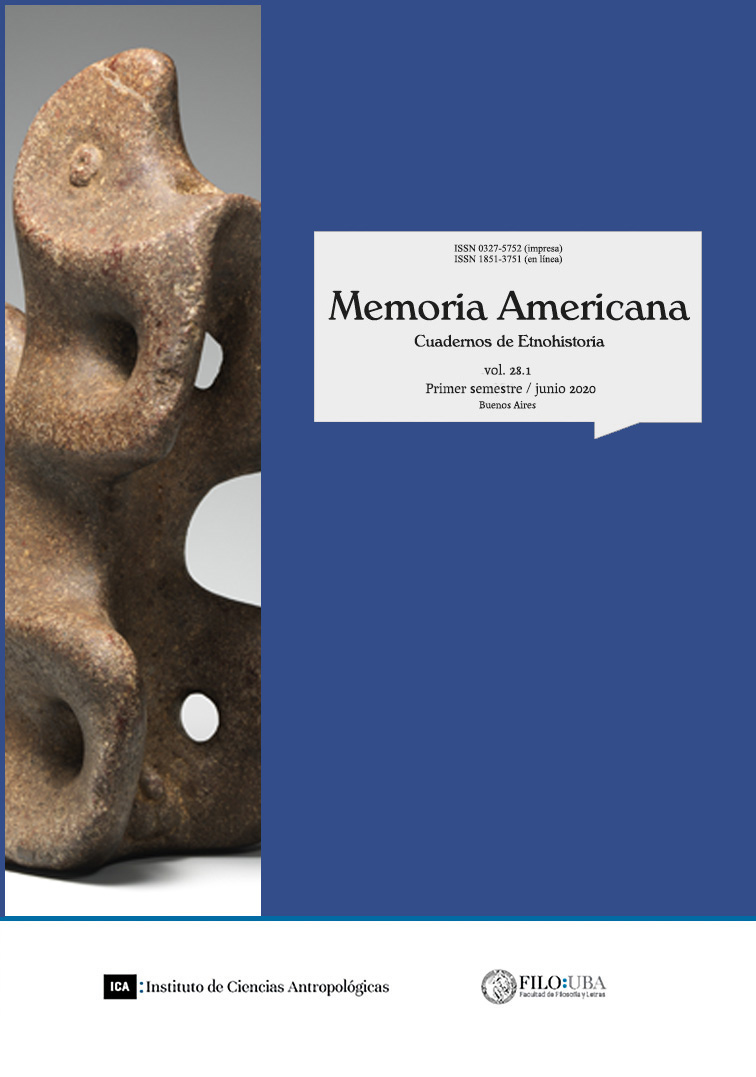Los “usos” de Tomás Paniri: acción científica, indígena y estatal en el norte andino de Chile
Resumen
En 1993 el Estado chileno reconoció la preexistencia en el suelo nacional de diversos grupos étnicos y propuso implementar políticas especializadas; desde entonces los atacameños de la región de Antofagasta iniciaron un proceso de organización que los coloca actualmente como actores de importancia en las discusiones sobre la administración del territorio y sus recursos. La combinación entre elementos del saber experto -o científico- y el saber tradicional -o étnico- ocupa un papel fundamental en las estrategias desarrolladas. En este artículo presentaré un estudio de caso: el uso de la figura de Tomás Paniri, líder indígena del siglo XVIII. Distinguiré tres momentos: el primero, su construcción como sujeto histórico a través de descubrimientos documentales (1970-ad.); el segundo, su transformación en símbolo del movimiento atacameño (1990-ad.); y el tercero, su incorporación a las narrativas estatales de lo multicultural. El análisis me permitirá mostrar diferentes tipos de articulación entre atacameños, campo académico y Estado y, al mismo tiempo, esbozar las tensiones discursivas en las que se inscribe la categoría de lo atacameño.Descargas
Citas
Avendaño Pinto, S. (2009). Áreas de Desarrollo Indígena en el norte de Chile. Negociaciones y disputas en torno a espacios territoriales. Tesis para optar al Grado de Magíster en Ciencias Sociales, Mención Sociología de la Modernización. Universidad de Chile, Facultad de Ciencias Sociales. Santiago de Chile. Disponible en Internet: http://repositorio.uchile.cl/bitstream/handle/2250/105758/cs-avendano_s.pdf?sequence=3&isAllowed=y Consultada el: 4 de febrero de 2018.
Chiappe, C. (2016). La ley N° 17.729. Desarrollo e integración del sujeto indígena en una época de polarización política (Chile, 1972). Historia y justicia 7: 39-66.
Consejo de Pueblos Atacameños (2019). Boletín 2. San Pedro de Atacama.
González Miranda, S. (2009). El Norte Grande de Chile: la definición histórica de sus límites, zonas y líneas de fronteras, y la importancia de las ciudades como geosímbolos fronterizos. Revista Idea 2 (13): s/n. Disponible en Internet:
http://www.revistas.usach.cl/ojs/index.php/historiasocial/article/view/98/89. Consultada el: 4 de febrero de 2018.
Gundermann, H. (2000). Las organizaciones étnicas y el discurso de la identidad en el norte de Chile, 1980-2000. Estudios atacameños 19: 75-91.
Gundermann, H. (2001). Procesos regionales y poblaciones indígenas en el norte de de Chile. Estudios Atacameños 21: 89-112.
Gundermann, H. (2013). Procesos étnicos y cultura en los pueblos indígenas de Chile. Alpha 36: 93-108.
Gundermann, H. (2018). Los pueblos originarios del norte de Chile y el Estado. Diálogo Andino 55: 93-109.
Gundermann, H. y H. González (2008). Pautas de integración regional, migración, movilidad y redes sociales en los pueblos indígenas de Chile. Universum 23 (1): 82-115.
Gundermann, H. y H. González (2009). Sociedades indígenas y conocimiento antropológico. Aymaras y atacameños de los siglos XIX y XX. Chungara 41 (1): 113-164.
Hidalgo, J. (1982). Fases de la rebelión indígena de 1781 en el Corregimiento de Atacama y esquema de la inestabilidad política que precede, 1749-1781. Chungara 9: 192-246.
Hidalgo, J. (1986). “Indian Society in Arica, Tarapacá and Atacama, 1750-1793 and its response to the rebelion of Tupac Amaru”. Tesis doctoral para obtener el grado de Doctor of Philosophy. Londres, University of London.
Hidalgo, J. (2017). Entrevista a Jorge Hidalgo Leheudé. Realizada en Santiago de Chile por Carlos Chiappe.
Hidalgo, J. y P. Arévalo (1987). Atacama antes y después de la rebelión de 1781: Siete documentos inéditos del Archivo General de la Nación Argentina (A.G.A.). Chungara 18: 91-100.
Jofré Saavedra, K. (2016). “Conmemoraron la muerte del héroe indígena Tomas Paniri en Calama”. El Mercurio de Calama. Disponible en Internet: https://www.soychile.cl/Calama/Cultura/2016/05/13/393129/Conmemoraron-la-muerte-del-heroe-indigena-Tomas-Paniri-en-Calama.aspx Consultada el: 4 de mayo de 2017
Le Paige, G. (1963). Continuidad o discontinuidad de la cultura atacameña. Anales de la Universidad del Norte 2: 7-28.
Ministerio de Planificación y Cooperación (1993). Ley N° 19253. Disponible en internet: https://www.leychile.cl/Navegar?idNorma=30620. Consultada el: 2 de mayo de 2015.
Pávez Ojeda, J. (2015). Laboratorios etnográficos. Los archivos de la antropología en Chile (1880-1980). Santiago de Chile, Ediciones Universidad Alberto Hurtado.
Saire Saire, J., Segovia Bartolo, W. y C. Mondaca Rojas (2008). Tomas Paniri. Desde Ayquina a Ckalama. Por los senderos de un líder Indígena. San Pedro de Atacama, CONADI.
Segovia Bartolo, W. (2015). Tomás Paniri, la imposición de un nuevo orden en Atacama. IV Jornada de Historia Regional de Antofagasta. Disponible en Internet: http://www.youtube.com/watch?v= 7WkJEEpqMS4. Consultada el: 12 de julio de 2016.
Smith, L. (2011). El “espejo patrimonial” ¿Ilusión narcisista o reflexiones múltiples? Antípoda 12: 39-63.
Valenzuela, A. (2006). Atacameños de Calama. Diversidad, transitoriedad y fragmentación en las organizaciones atacameñas urbanas y su relación con el Estado chileno. Tesis para obtener el grado de Maestra en Antropología Social. Guadalajara, CIESAS. Disponible en Internet: https://docplayer.es/67910471-Atacamenos-de-calama-diversidad-transitoriedad-y-fragmentacion-en-las-organizaciones-atacamenas-urbanas-y-su-relacion-con-el-estado-chileno.html. Consultada el: 4 de mayo de 2017
Derechos de autor 2025 Memoria Americana. Cuadernos de Etnohistoria

Esta obra está bajo licencia internacional Creative Commons Reconocimiento-NoComercial-CompartirIgual 4.0.
Los derechos de autor son cedidos a Memoria Americana. Cuadernos de Etnohistoria, no obstante los autores podrán recuperarlos y reproducir su trabajo en otros medios o formatos previo envío de solicitud al Comité Editorial. En tales casos, deberá citarse a Memoria Americana. Cuadernos de Etnohistoria como primera publicación del trabajo y el mismo queda bajo una licencia Creative Commons CC BY NC SA 3.0 Attribution- Non Commercial -ShareAlike 3.0, la cual provee libre acceso inmediato a sus contenidos pues se rige por el principio según el cual hacer disponible -en forma gratuita- la investigación al público fomenta un mayor intercambio de conocimiento a nivel global.
Los autores deberán remitir el siguiente formulario de cesión de derechos y compromiso de originalidad:
Cesión de derechos y compromiso de originalidad
Al Comité Editorial de Memoria Americana, Cuadernos de Etnohistoria
Por la presente declaro ser el autor del trabajo titulado (nombre del artículo), el mismo es original y propio y no ha sido publicado en ningún formato o soporte con anterioridad.
En caso de ser aceptado para su publicación en Memoria Americana. Cuadernos de Etnohistoria (número/año) cedo los derechos editoriales que me corresponden por el aludido artículo para su publicación en todos los formatos que posea la mencionada revista.
Si quisiera publicar este artículo a través de otro editor o en otro lugar me comprometo a solicitar el correspondiente permiso por escrito al Comité Editorial de Memoria Americana. Cuadernos de Etnohistoria. De ser afirmativa la respuesta del Comité Editorial me comprometo a lo siguiente:
- especificar lugar, editorial y fecha de la primera publicación del artículo en la nueva publicación
- realizar esta republicación sólo luego de transcurridos un año calendario desde la fecha de la presente nota de cesión de derechos
FIRMA
Aclaración












